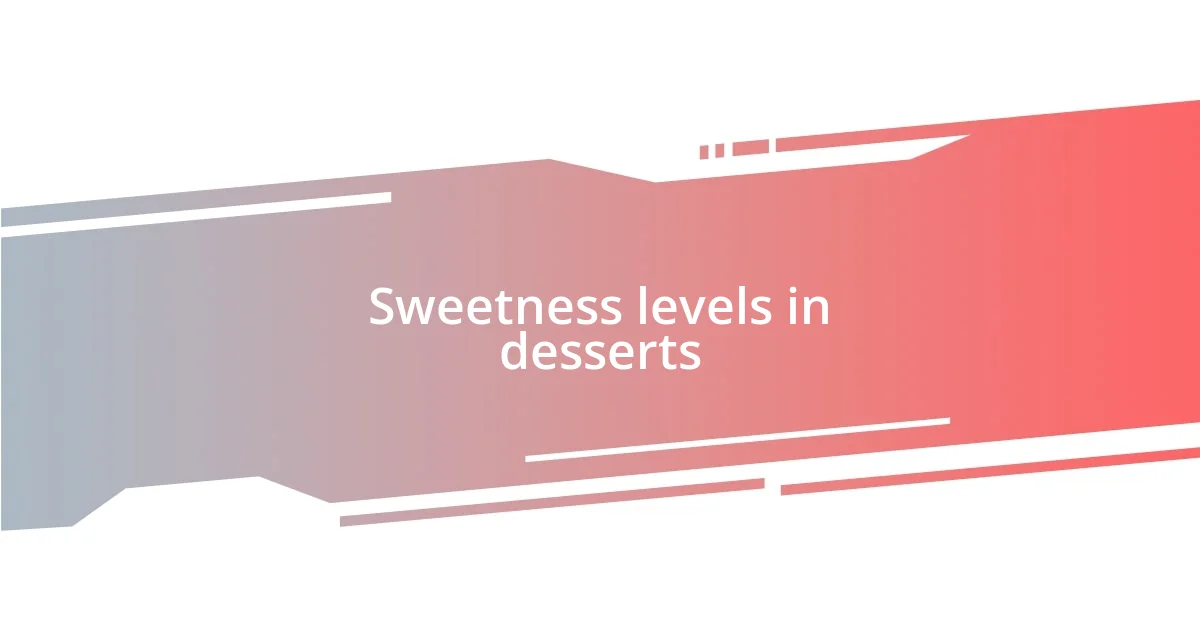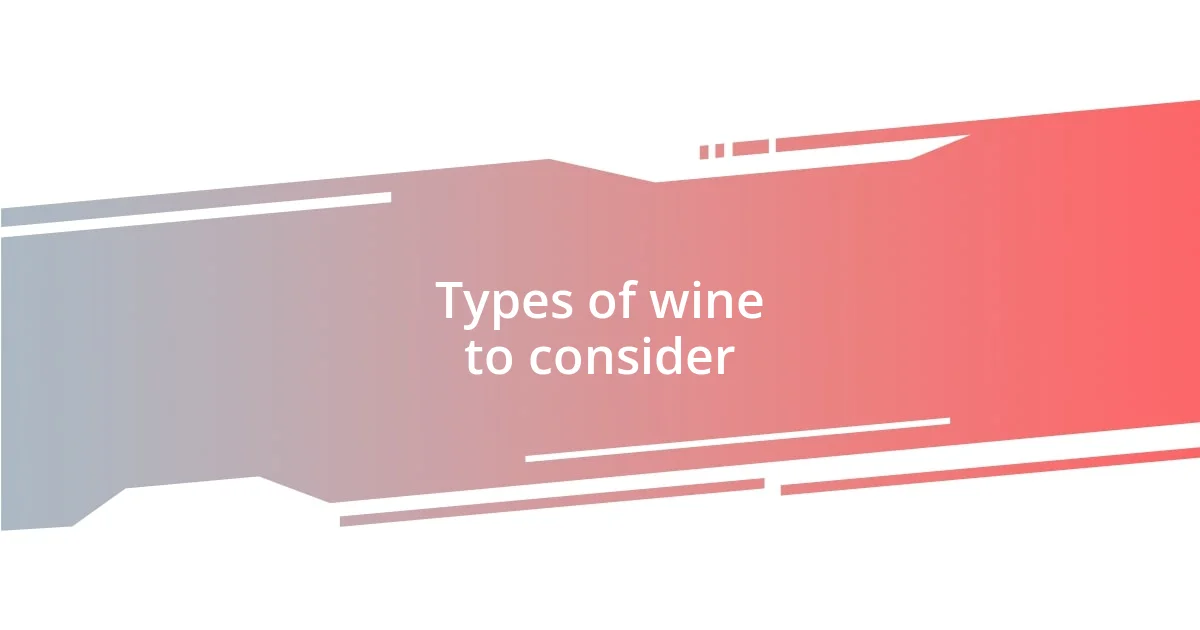Key takeaways:
- Successful dessert and wine pairing relies on balancing sweetness levels, acidity, body, and texture to enhance flavors and create harmony.
- Experimentation is encouraged, as unexpected combinations can lead to delightful surprises and elevate the overall dining experience.
- Avoid common mistakes such as pairing sweeter wines with overly sweet desserts, neglecting texture compatibility, and disregarding the occasion’s vibe for dessert choices.

Understanding dessert and wine pairing
Pairing dessert with wine is like finding the perfect dance partner; it’s all about harmony and balance. I remember the first time I tasted a rich chocolate cake with a bold port wine. The sweetness of the cake complemented the deep, fruity notes of the wine beautifully, creating an experience that felt almost magical. Have you ever experienced a moment where two flavors just clicked? It’s those kinds of pairings that turn an ordinary meal into something truly special.
When considering dessert and wine, think about the dominant flavors in each. For example, fruity desserts often shine alongside sweeter wines, like Riesling or Moscato, which can elevate the freshness of the dish. I once enjoyed a tangy lemon tart paired with a late-harvest Sauvignon Blanc, and the combination brought out the tartness of the dessert in a way that was simply unforgettable. Have you ever tried to match lighter dishes with lighter wines? The result can be an incredibly refreshing experience.
Additionally, don’t shy away from experimenting. I once decided to pair a spice-laden pumpkin pie with a sparkling wine, and the effervescence cut through the richness, offering a delightful contrast. It’s always exciting to find unexpected matches that surprise your palate. What’s holding you back from trying unique pairings? Embrace the process, and you might stumble upon your new favorite duo!

Importance of flavor profiles
Understanding the importance of flavor profiles is crucial for successful dessert and wine pairings. Each element has its distinct characteristics that can either complement or clash with each other. I recall a time when I paired a delicate vanilla panna cotta with a sweet Sauternes. The richness of the panna cotta contrasted beautifully with Sauternes’ honeyed notes, providing a delicious harmony that lingered long after the last bite. Discovering how these profiles interact can elevate your dining experience to a whole new level.
When matching dessert with wine, it’s essential to consider the following aspects of flavor profiles:
- Sweetness Level: The sweetness of the dessert should match or be less than the sweetness of the wine to avoid overwhelming the palate.
- Acidity: A dessert with high acidity, like a fruit tart, benefits from a wine that has a refreshing acidity to balance the flavors.
- Body: The weight and richness of the dessert should correlate with the body of the wine—lighter wines with lighter desserts, and fuller-bodied wines with denser options.
- Bitterness: Desserts with bitter elements, such as dark chocolate, pair well with sweet wines to create a contrasting yet harmonious taste.

Sweetness levels in desserts
Understanding sweetness levels in desserts is vital for a successful pairing with wine. A dessert’s sweetness can significantly influence how we perceive both the dish and the wine. For instance, I had a moment when a delectable crème brûlée met a sweet Muscat. The creamy custard’s caramelized topping brought out the lush apricot notes in the wine, creating a delicate dance of flavors that lingered in my memory. Have you experienced something similar when the right wine made a dessert shine?
Moreover, not all desserts are created equal when it comes to sweetness. Some may have a subtle sweetness, like a lemon sorbet, while others, such as a fudge brownie, can hit you with a sugar rush. I recall indulging in a berry tart drizzled with a hint of honey paired with a light, off-dry white wine; the balance was impeccable. How do you feel about sweetness levels—do you prefer a gentle caress of sweetness, or does a bold hit excite your palate?
Finally, the key to mastering dessert pairings lies in understanding how sweetness interacts with wine. Matching sweeter desserts with wines that mirror or exceed that sweetness helps to create a harmonious experience. My encounter with a rich tiramisu and a late-harvest Riesling was one such instance; the wine’s sweetness enhanced the coffee flavors in the dessert, making it utterly unforgettable. Isn’t it fascinating how sweetness can transform the experience?
| Dessert Type | Sweetness Level |
|---|---|
| Crème Brûlée | High |
| Lemon Sorbet | Low |
| Fudge Brownie | Very High |
| Berry Tart | Medium |
| Tiramisu | High |

Types of wine to consider
When it comes to types of wine, I always find myself gravitating towards dessert wines like Port or Late Bottled Vintage. These wines can have rich, concentrated flavors that complement even the most decadent of desserts. I remember savoring a slice of chocolate lava cake paired with a glass of Ruby Port; the wine’s dark berry notes resonated beautifully with the molten chocolate. Have you ever paired a dessert wine with your favorite dish? It can be a game-changer.
On the other hand, I often explore the realm of sparkling wines, particularly when I’m indulging in lighter desserts. A delicate mousse or a fruit tart shines alongside a refreshing Prosecco or Champagne. The effervescence lifts the flavors, creating a joyful experience. Just the other day, I had a delightful strawberry mousse with a bubbly Cava that turned an ordinary afternoon into a celebration. Isn’t it amazing how the right type of wine transports you to a different mood?
Don’t overlook white wines either! A sweet Riesling or a fruity Sauvignon Blanc can create a stunning contrast with various desserts. I’ve had success pairing a sweet Riesling with a coconut cream pie, where the wine’s acidity balanced out the dessert’s creaminess perfectly. It’s moments like these that remind me why I love experimenting with wine pairings; they open up a world of potential flavor combinations just waiting to be discovered. Have you embarked on your own adventure with different types of wine? The possibilities are endless!

Recommended dessert and wine combinations
One of my all-time favorite combinations is a classic fruit tart paired with a crisp Sauvignon Blanc. The wine’s zesty notes complement the tart’s fresh fruitiness beautifully, creating a symphony of flavors. I still remember the day I enjoyed this pairing during a summer picnic; each bite of the tart paired with a sip of wine felt like a celebration of sunshine. Have you ever experienced such a burst of joy from a simple dessert?
For an indulgent evening, a gooey chocolate brownie paired with a bold Cabernet Sauvignon is heavenly. The wine’s rich tannins cut through the dense brownie, enhancing the chocolate’s depth. I can vividly recall a rainy evening when this combination made my day improve remarkably; the flavors seemed to ignite warmth in every bite and sip. Isn’t it remarkable how certain pairings can transform an entire mood?
When it comes to lighter desserts, nothing beats a delicate panna cotta with a sweet Moscato. The floral and stone fruit notes in the wine elevate the creamy texture of the panna cotta, resulting in pure bliss. I still relish the evening I shared this delightful pairing with a friend under twinkling stars; it’s those little moments that leave a lasting impression. Have you discovered a pairing that has brought you closer to someone special?

Tips for successful pairing
When it comes to pairing dessert with wine, I’ve learned that balancing flavors is key. For instance, if you’re enjoying something sweet like a chocolate dessert, a wine with good acidity, such as a Port, often works wonders. I once paired a rich chocolate mousse with a slightly tart wine, and it was like the two found a harmony that elevated the entire experience. Have you ever noticed how the right contrast can bring out hidden depths in each flavor?
Temperature plays a crucial role in successful pairings too. I remember chilling a sweet Riesling before enjoying it with a slice of lemon tart, and the coolness of the wine made the tart’s citrus notes sing. It’s fascinating how temperature affects both the dessert and the wine; serving them at the right temperature can enhance the flavors significantly. Have you tried experimenting with temperature before? Sometimes, it’s the simplest tweaks that create the most memorable moments.
Another tip I swear by involves considering the texture of both the dessert and the wine. A creamy dessert pairs wonderfully with a wine that has a similar mouthfeel. I once had a velvety panna cotta with a luscious late harvest Sauvignon Blanc, where the creamy richness of both elements seemed to wrap around me like a warm hug. Such pairings can create a comforting and indulgent experience. What’s your favorite texture contrast that you’ve experienced? It’s these combinations that often stick with us, isn’t it?

Common pairing mistakes to avoid
One common mistake I’ve encountered in dessert and wine pairing is choosing a wine that’s sweeter than the dessert itself. I remember once pairing a cloyingly sweet dessert with a syrupy wine, thinking it would create a delightful match. Instead, the flavors clashed dramatically, leaving a lingering, overly sweet taste that overshadowed both. Have you ever experienced a pairing that just didn’t work? It’s a real letdown.
Another pitfall is ignoring the dessert’s texture. I’ll never forget the time I paired a light, airy soufflé with a heavy red wine, thinking bold flavors would impress. Instead, the wine overwhelmed the delicate dessert, making each bite feel awkward rather than harmonious. This taught me that the weight of both components matters; have you found that the right texture can elevate or detract from the pairing experience?
Finally, not considering the occasion can lead to pairing blunders. I once brought a rich cheesecake to a summer barbecue, happily thinking it would be a hit. The guests were more in the mood for refreshing, light desserts, and my cheesecake felt out of place. It was a learning moment for me—what’s the vibe of the gathering? Ensuring that your dessert and wine pairings align with the occasion can make all the difference. Have you ever chosen a dessert that didn’t resonate with the gathering’s energy?















